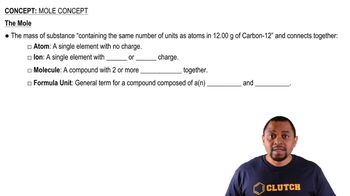Write the balanced chemical equation for the reaction of aqueous potassium hydroxide with aqueous iron(III) chloride to form solid iron(III) hydroxide and aqueous potassium chloride.
Balance the equation and calculate how many moles of O2 form when each quantity of reactant completely reacts. N2O5( g) → NO2(g) + O2(g) a. 1.2 mol N2O5
 Verified step by step guidance
Verified step by step guidance
Verified video answer for a similar problem:
Key Concepts
Balancing Chemical Equations

Stoichiometry

Mole Concept

Balance each chemical equation. b. Co(NO3)3(aq) + (NH4)2S(aq) → Co2S3(s) + NH4NO3(aq)
Consider the unbalanced equation for the neutralization of acetic acid: HC2H3O2(aq) + Ba(OH)2(aq) → H2O(l) + Ba(C2H3O2)2(aq) Balance the equation and determine how many moles of Ba(OH)2 are required to completely neutralize 1.22 mol of HC2H3O2.
Balance the equation and calculate how many moles of N2 form when each quantity of reactant completely reacts. N2H4(l) → NH3(g) + N2(g) c. 33.9 g N2H4
Consider the balanced equation:
SiO2(s) + 3 C(s) → SiC(s) + 2 CO(g)
Complete the table showing the appropriate number of moles of reactants and products. If the number of moles of a reactant is provided, fill in the required amount of the other reactant, as well as the moles of each product that forms. If the number of moles of a product is provided, fill in the required amount of each reactant to make that amount of product, as well as the amount of the other product that forms.
Consider the balanced equation:
SiO2(s) + 3 C(s) → SiC(s) + 2 CO(g)
Complete the table showing the appropriate number of moles of reactants and products. If the number of moles of a reactant is provided, fill in the required amount of the other reactant, as well as the moles of each product that forms. If the number of moles of a product is provided, fill in the required amount of each reactant to make that amount of product, as well as the amount of the other product that forms.
